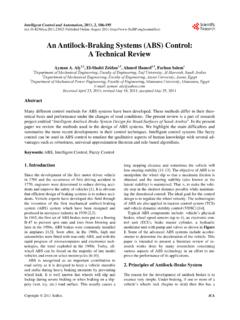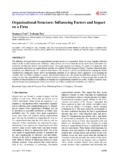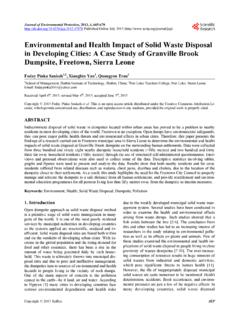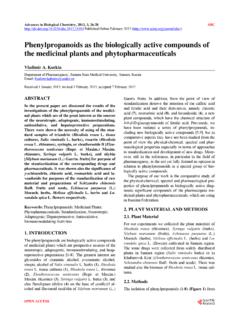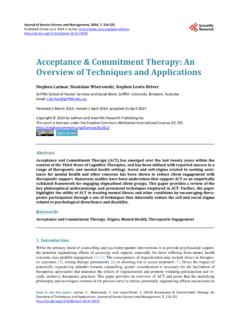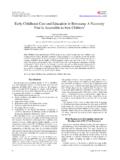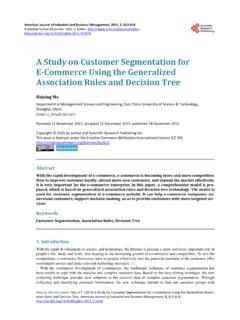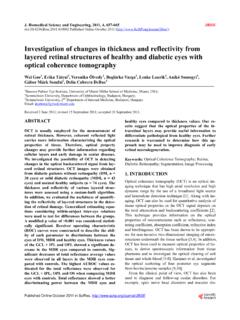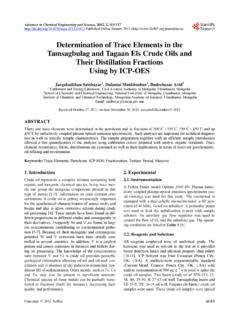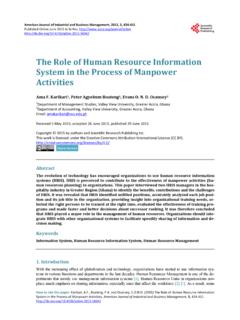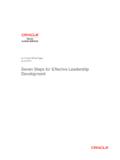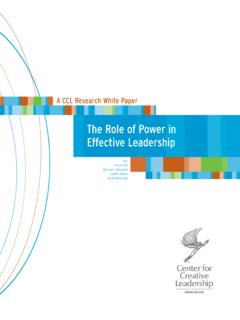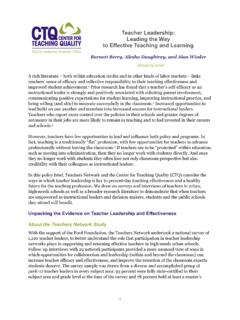Transcription of Qualities of Effective Leadership in Higher Education
1 Open Journal of Leadership , 2015, 4, 54-66 Published Online June 2015 in SciRes. How to cite this paper: Black, S. A. (2015). Qualities of Effective Leadership in Higher Education . Open Journal of Leadership , 4, 54-66. Qualities of Effective Leadership in Higher Education Simon A. Black Department of Human Resources, University of Kent, Canterbury, UK Email: Received 17 April 2015; accepted 13 June 2015; published 16 June 2015 Copyright 2015 by author and Scientific Research Publishing Inc. This work is licensed under the Creative Commons Attribution International License (CC BY). Abstract The Leadership of Higher Education institutions has been placed under increasing scrutiny since the 1980s with the expansion of student numbers, changes in funding for student places, increased marketization and student choice, and continuing globalisation of the sector.
2 In this climate of change Higher Education institutions have been required to consider how to develop their leaders and what might be appropriate Leadership behaviour to enable adaptation to these new circum-stances. When the various paradigms of Leadership encountered in the Higher Education sector are compared with established Leadership theory and practice it is possible to identify further in-tricacies in the development of Higher Education leaders. Further consideration of practicalities within Higher Education identifies whether competence frameworks might assist in Leadership development. An examination of a recently-developed comprehensive framework of Leadership capabilities applied in an alternative sector leads to an evaluation as to whether the same con-structs apply to the demands placed upon leaders in Higher Education .
3 Analysis demonstrates that, with minor changes in terminology, the constructs remain appropriate and valid. The definitions of activities and behaviours offer insight into how Higher Education leaders could be developed and therefore form a potential framework of Leadership capabilities for Higher Education . Keywords Higher Education , Systems Thinking, Competencies, Transformation, Competence Framework 1. Introduction There has been a growing interest in the role of leaders within Higher Education (HE) institutions in recent years, driven both by the influence of HE institutions in developing learners who later develop as leaders in wider so-ciety, and by the changing shape of HE Leadership itself in the face of global challenges in the sector.
4 Several contextual shifts have occurred within the Higher Education sector in recent decades, particularly globalisation S. A. Black 55 of the market and internationalisation of institutions, development of for-profit private institutions, cutbacks in public funding and increased cross-border academic mobility (Gibbons, 1998; Middlehurst, 1999; Schofer & Meyer, 2005; Altbach, 2011). Since the 1990s the Leadership approach encountered in UK Higher Education in-stitutions has been placed under increasing scrutiny with the need to adapt to a huge expansion in student num-bers and the development of a fee-paying culture (Deem, 1998) which has changed expectations to a more out-ward-facing student focused approach, largely at odds with the traditional inward-looking collegial approach (Davies, Hides, & Casey, 2001).
5 This change has driven a move in UK institutions from administration (keeping things ticking over) to a pervading management culture ever since (Clegg & McAuley, 2005), with compara-ble change in management functions of North American colleges observed since the 1980s (Amey, 2006). Leaders in HE institutions have to examine how to better lead their organisations, and must also find ap-proaches which fit best in the HE context; the most Effective Leadership approach. However, this is not straightforward since there is no clear consensus on the definition of Leadership (Kennedy, 1994) and the parallel and sometimes interweaving evolution of Leadership ideologies complicate the picture. Over the past 100 years several broad philosophies have emerged and can be seen to persist in various guises in modern organisations: 1) Command-and-control Leadership has proliferated since the 19th Century industrial era, drawing on rules, incentives, threats, contracts, and standards (Macdonald, 1998), evolving into quasi-military concepts through the 1940s (Kennedy, 1994).
6 This scientific management approach focuses on efficiency of the or-ganizational machine ; managers make decisions, specialists work in separate functions, and work is con-tinually simplified. 2) Behavioural theories emerged in the 1950s, based upon more complete considerations of human nature and motivation (McGregor, 1957; Herzberg, 1976). Situational Leadership (Hersey & Blanchard 1969) called for adaptation of style relative to staff competence and the task, whilst Adair (1979) added considerations of team dynamics into this context. 3) Transactional-transformational models in the 1970s (Burns, 1978; Bass, 1997) involve reinforcement of performance ( transactional behaviour), alongside understanding followers, and building their self-worth and focus ( transformational behaviors).
7 Credibility, vision, values, competence, judgment, experimenta-tion, and engagement of staff are emphasised (Peters & Waterman, 1982; Kouzes & Posner, 2007; Bennis 1999, 2009). 4) Transformational Leadership and the emphasis of transformational behavior has become the sole dominant paradigm over the past 20 years (Kennedy, 1994; Tourish, 2008). Leaders are portrayed as heroes (Slater, 1999; Kanter, 2003) and are encouraged to transform the loyalties and behaviors of their staff through a shared organizational culture. Negative effects may arise however; dialogue may become stifled, prob-lem-solving may diminish (Seddon, 2003; Tourish, 2008) and people can be perceived as the source of problems (Heifetz & Laurie, 1997).
8 The coercion of people is reminiscent of command-and-control s struc-tures and rules (Black, Groombridge, & Jones, 2011). 5) Systems Thinking was applied to management in the 1920s (Shewhart, 1931) and further developed in the 1940s by Deming (1982). A Systems Thinking leader aims to optimize links between manager behavior, rules, structure, decision-making, skills, methods, and results (Senge, 1990; Womack & Jones, 1996; Oak-land, 2001). Leaders aim to work on the system which is a fundamental change from the mantra of com-mand-and-control and transformational leaders which emphasises working on people (Seddon, 2003). In order to examine the relevance of Leadership constructs within the HE environment it is necessary to com-pare the existing understanding of Leadership within HE alongside contemporary Leadership theory and practice.
9 Thereafter, where comprehensive Leadership competence frameworks already exist ( descriptions of leader-ship activities and capabilities) these could be tested in relation to the demands of the HE sector. A recently de-veloped sector-specific model in biodiversity conservation (Black, Groombridge, & Jones, 2011) provides just such a potential comparator. This discussion examines whether, after suitable translation of terminology, the subsequently developed HE Leadership framework remains valid, robust and relevant when tested in the context of Leadership challenges encountered in Higher Education . 2. The Leadership Context in Higher Education Leadership roles in academic institutions have a number of anomalies; whilst traditional senior executive roles ( Vice-Chancellor, Chief Executive, President, Vice-President, pro-Vice Chancellor) resonate with executive S.
10 A. Black 56 roles encountered in other sectors, academic Leadership roles (such as Deans or Heads of School) are unusual and commonly have complications such as transitory nature of role-holders (for example on a 3-year rotating basis, much like a secondment). Also, traditionally in some situations, academic roles can be given on an almost honorary basis as first among equals to a senior or established professor (Davies, Hides, & Casey, 2001). Fac-ulty positions usually combine the role of teacher, scholar, researcher and institutional citizen (Astin & Astin, 2000) all of which have Leadership responsibility in some form or other, either explicitly or implicitly specified within the role.
